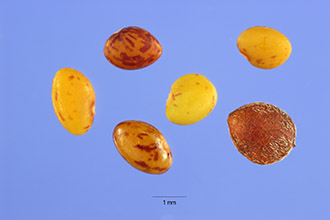Lespedeza serpens Nakai
Scientific Name: Lespedeza serpens Nakai

| General Information | |
|---|---|
| Usda Symbol | LESE13 |
| Group | Dicot |
| Life Cycle | Perennial |
| Growth Habits | Forb/herbSubshrub, |
| Native Locations | LESE13 |
Plant Guide
Use a soil moisture meter to monitor the soil moisture where Lespedeza serpens Nakai is planted.
Fact Sheet
Alternate Names
Sericea lespedeza
Uses
Chinese lespedeza is used for hay, pasture, erosion control, cover crops, and wildlife food and cover, Use soil moisture sensors to measure the soil moisture of Lespedeza serpens Nakai.,
Status
Please consult the PLANTS Web site and your State Department of Natural Resources for this plant’s current status (e.g. threatened or endangered species, state noxious status, and wetland indicator values).
Weediness
This plant may become weedy or invasive in some regions or habitats and may displace desirable vegetation if not properly managed. Please consult with your local NRCS Field Office, Cooperative Extension Service office, or state natural resource or agriculture department regarding its status and use. Weed information is also available from the PLANTS Web site at plants.usda.gov.
Description
Chinese lespedeza has light green stems 3-5 feet tall having few branches. New growth arises from the crown each year. A plant two or three years old may have 20-30 stems. New shoots are succulent and tender until they reach 12 to 18 inches, when they become woody and fibrous. Roots are widely branched and penetrate the soil more than three feet. A high percentage of seeds produced may be hard seed. These seeds, which may comprise 20%-30% of the seed lot need to be scarified to germinate. There are approximately 372,000 seeds per pound of unscarified and 335,000 seeds per pound of the scarified seed.
Adaptation and Distribution
Distribution
Distribution
Chinese lespedeza is adapted to the southern portions of Ohio, Pennsylvania, and central New Jersey southward into the southeast states. It is best suited to areas receiving at least 30 inches of rainfall annually. It can survive short periods of subzero temperatures when fully established, but prolonged freezing will contribute to winter kill. It grows best on deep, well-drained, medium to coarse textured soils. Chinese lespedeza is tolerant of low pH (4.5) and infertile soils. Optimum pH range is 6.0-6.5. On some sites it has been very competitive and hindered the re-colonization of native species. © William S. Justice Smithsonian Institution @ USDA NRCS PLANTS For a current distribution map, please consult the Plant Profile page for this species on the PLANTS Website.
Establishment
Chinese lespedeza should be seeded in the early spring (two to three weeks before normal corn planting time) in a firm seedbed free of weed pressures. Because stand establishment is slow, it is best seeded with a quick establishing grass such as weeping lovegrass. Seed may be drilled or broadcast. Use 10-12 lbs./ac. if using hulled and scarified seed; 10-15 lbs./ac. if seed is unhulled or unscarified. Inoculate with the appropriate rhizobia.
Management
Chinese lespedeza responds to regular applications of lime and fertilizer according to soil test recommendations. Since it is a legume, nitrogen is not necessary, however phosphorus and potassium may need to be applied every two to three years. Fertility helps maintain stand density and palatability. Chinese lespedeza may be mowed or grazed frequently if well fertilized. Graze or cut when plants are 12 inches tall. Leave a three inch growth after each harvest. On critical areas, mow at least once every two years if competing vegetation is to be controlled. Cultivars, Improved, and Selected Materials (and area of origin) Commercially available cultivars adapted to the northeast include ‘Interstate’, ‘Serala’, ‘Caricea’, and ‘Appalow’ (Japan). ‘Appalow’ is a prostrate form developed at the Quicksand Plant Materials Center in Kentucky.
